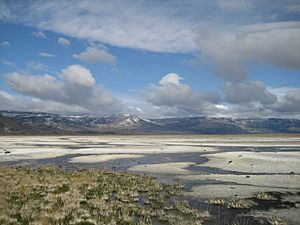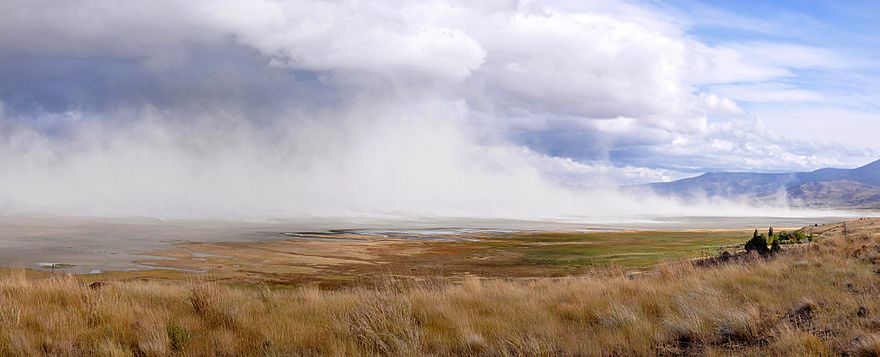Summer Lake (Oregon) facts for kids
Quick facts for kids Summer Lake |
|
|---|---|

Summer Lake
|
|
| Location | Lake County, Oregon, United States |
| Coordinates | 42°50′N 120°45′W / 42.83°N 120.75°W |
| Type | Natural, endorheic, hypereutrophic |
| Primary inflows | Ana River |
| Primary outflows | Evaporation |
| Catchment area | 376 square miles (970 km2) |
| Basin countries | United States |
| Max. length | 15 miles (24 km) |
| Max. width | 5 miles (8 km) |
| Surface area | 25,000 acres (10,000 ha) |
| Average depth | 1 foot (0.30 m) |
| Max. depth | 5 feet (1.5 m) |
| Water volume | 25,000 acre-feet (31,000,000 m3) |
| Residence time | 3.5 years |
| Shore length1 | 35 miles (56 km) |
| Surface elevation | 4,150 feet (1,260 m) |
| Settlements | Summer Lake, Paisley |
| 1 Shore length is not a well-defined measure. | |
Summer Lake is a large, shallow lake in Lake County, Oregon, United States. It's about 5 miles (8 km) south of the small town of Summer Lake, Oregon. When the water level is high, the lake is about 15 miles (24 km) long and 5 miles (8 km) wide.
This lake is a special place for many birds and other wildlife. It has lots of marshes where animals can live. An explorer named John C. Frémont named the lake during his trip in 1843.
Contents
The Ancient Lake Chewaucan
Long, long ago, the dry lands around Summer Lake were very wet. This was during a time called the Pleistocene Epoch, which was an ice age. Huge parts of southern Oregon were covered by lakes and wetlands.
As the last ice age ended, lots of rain and melting snow filled the low areas. This created a giant freshwater lake called Lake Chewaucan. This ancient lake was huge, covering about 461 square miles (1,190 km2). It was also very deep, up to 375 feet (114 m) in some places.
Lake Chewaucan covered the area where Summer Lake is now for a long time. The last time it was very full was about 13,000 years ago. Scientists have found signs that people lived near Lake Chewaucan during this time. The oldest human remains found in North and South America come from the Paisley Caves. These caves are about 10 miles southwest of Summer Lake.
Lake Chewaucan started to dry up as the ice age ended. As it got smaller, salts and other minerals became very strong in the water. The dry lake bottom turned into dust. Strong winds blew this dust to form the sand dunes you can still see on the east side of Summer Lake today.
Today, Summer Lake and Abert Lake are the only parts left of the huge Lake Chewaucan. They are about 20 miles (32 km) apart. Summer Lake's water level changes a lot. Sometimes, it can almost dry up in the summer. The main source of fresh water for Summer Lake is the small Ana River. This river is fed by springs and is also used to water farms.
John C. Frémont's Discovery
Captain John C. Frémont saw and named Summer Lake in 1843. He was on a trip to map central Oregon for the Army. His team was mapping the Oregon Territory from The Dalles to Sutter's Fort in California.
On December 16, 1843, Fremont's group had a tough time climbing down a steep cliff. They were coming from a snowy area and saw a big lake in the valley below. Fremont decided to call the snowy rim "Winter Ridge." He named the warmer lake "Summer Lake" because it was such a big change from the cold mountain.
Fremont wrote about finding the lake:
At our feet...more than a thousand feet below...we looked into a green prairie country, in which a beautiful lake, some twenty miles in length, was spread along the foot of the mountain...Shivering on snow three feet deep, and stiffening in a cold north wind, we exclaimed at once that the names of summer lake and winter ridge should be applied to these proximate places of such sudden and violent contrast.
—John C. Fremont, 16 December 1843, Report, Second Expedition
A Home for Wildlife
The Summer Lake area is home to over 250 different kinds of birds. These include amazing birds like bald eagles, Canada geese, and great blue herons. You can also see white-faced ibis, yellow-headed blackbirds, and many types of ducks.
Because of all the birds, Summer Lake is a popular spot for bird watching and hunting.
The Oregon Department of Fish and Wildlife manages the Summer Lake Wildlife Area. This area is on the north side of the lake. It has a large wetland marsh that gets water from the Ana River. There are also dry, high desert areas nearby. You can drive an 8.3-mile (13.4 km) tour route through the refuge most of the year. The main office for the refuge is near Oregon Route 31, right across from the Summer Lake Lodge.
The "Dirty Rain" Dust Storm
On February 6, 2015, something unusual happened. Dust from Summer Lake was picked up by strong winds, blowing up to 60 miles per hour (97 km/h). This dust is believed to have caused "dirty rain" in parts of three U.S. states: Oregon, Washington, and Idaho.
Scientists at Washington State University studied this event. They found that a strange mix of weather systems carried the dust far away. It traveled up to 500 miles (800 km) north and northeast. There, it mixed with rain, making the rain look "milky." This chalky dust left a coating on cars and windows in cities like Hermiston and Spokane.



